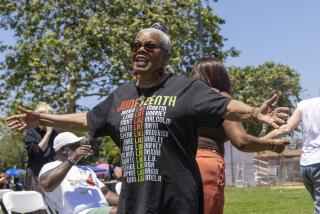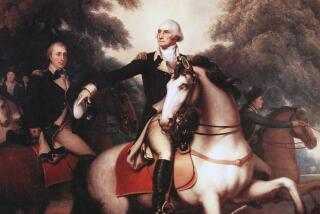‘A History and Civics Lesson for Everyone’ : Bicentennial Fete of Constitution Taking Shape
- Share via
PHILADELPHIA — A silver inkstand and a chair carved with a rising sun are the only original pieces left in the assembly room at Philadelphia’s Independence Hall, where representatives of the 13 colonies met to debate, deliberate on and finally deliver to an embryonic nation the four-page parchment document that would become the Constitution of the United States.
Now, 200 years after the signing of the Constitution, the country is launching a coast-to-coast celebration.
It will bring the entire U.S. Congress to Philadelphia for a one-day session in a specially constructed space-age pavilion. It will include a television special by the producers of the Statue of Liberty Weekend ceremonies and flood the country with approved souvenirs varying from tote bags to California wines with special labels.
Framework of Democracy
Planners hope the pomp will not overshadow the opportunity to re-examine the document that has laid a framework of democratic government for countries around the world.
“This is an occasion for a history and civics lesson for everyone,” says former Chief Justice Warren E. Burger, chairman of the Commission on the Bicentennial of the United States Constitution.
The celebration has been in the works, both nationally and locally in Philadelphia, for more than two years. The national commission, which Burger agreed to direct upon his retirement from the court last year, has received $25.2 million from Congress to sponsor and coordinate activities.
However, compared to the nation’s Bicentennial and the Statue of Liberty, which were celebrated in highly successful national galas in 1976 and 1986, the Constitution may not be as natural a centerpiece for a party.
Constitution’s Purpose
According to a recent poll conducted for the Hearst Corp., more than a fourth of Americans think the Constitution’s purpose was to declare independence from England. Fifty-nine percent of those surveyed did not know the Bill of Rights was the charter’s first 10 amendments.
“We have taken it for granted,” Burger lamented. “ . . . It’s not as easy to focus on.”
By year’s end, he hopes that will have changed.
“We want to put the emphasis on the history--how difficult it was, how we almost didn’t get the Constitution,” he said recently.
When the 55 delegates to the Constitutional Convention met in Philadelphia in May of 1787, the survival of the nation was at stake.
Economy in Depression
Under the Articles of Confederation passed 10 years earlier, the economy had fallen into depression, currency was unstable and the massive debt left from the War of Independence was unpaid. A weak central government, with no independent executive or power to tax, was unable to make effective treaties with other countries or regulate trade between the states, which acted virtually as autonomous nations.
With many representatives wary of any hint of tyranny, it was uncertain whether any agreement on a workable system could be reached, or whether the states should just go their separate ways. But over the next four months, the delegates, meeting in secret sessions and pitting heatedly the rights of states against the need for centralized power, hammered out a compromise that established the three branches of government and framed a system flexible enough to withstand 200 years of dynamic change.
The big breakthrough came on July 16, 1787, when the “Great Compromise” established Congress as we know it today: a lower house whose representation is based on population, and an upper house with two delegates from each state.
‘We the People . . . ‘
Two months later, on Sept. 17, 39 of the delegates signed the four-page document, opening with the now famous preamble, “We the People of the United States, in order to form a more perfect union. . . .” Then they returned home to tell the people what they had done.
It was, in the words of New York Rep. Sol Bloom, who chaired the sesquicentennial observance, “one of the greatest sessions of the wise men in the history of the world.”
Although there have been two previous constitutional celebrations, in 1887 and 1937, this year’s tribute to the feat is designed to be the most elaborate and lavish of all.
No medium or method will be overlooked. Kitsch will commingle with historical scholarship.
For starters, to better acquaint people with the honoree, 100 million copies of the Constitution will be distributed by corporations nationwide--equivalent to 30 copies for each of the 3.9 million people in the nation when it was signed.
Historical Lectures
Hundreds of lectures, symposiums and study groups will be held in cities to review the history of the Constitution and analyze its articles. AT&T; will offer recorded historical messages on a toll free telephone number, 1-800-3-B-PROUD, and Texas billionaire H. Ross Perot is expected to display the 1297 copy of the Magna Charta, the English document that set the precedent for civil and political liberties. Perot purchased it for $1.5 million in England two years ago.
On television, there will be a blitz of variety specials and historical series, underwritten by firms including Merrill Lynch, General Motors and Chrysler. In bookstores and catalogues, buyers will find a specially reissued edition of Catherine Drinker Bowen’s 1966 book, “Miracle at Philadelphia,” and a National Grange commemorative cookbook of 18th-Century recipes.
For novelty collectors, the choices will be endless. About 200 companies have already approached the national commission to inquire about licensing agreements that will enable them to carry the official bicentennial logo for such items as flags and taped readings of the Constitution. In return for lending the official seal, the commission will collect 6% to 10% of the sales receipts.
Commemorative Stamps
Already, the U.S. Postal Service has approved commemorative stamps. The national Bicentennial Commission has produced a calendar. The U.S. Capitol Historical Society is offering a series of 10 bicentennial medals in bronze, silver and gold, priced from $8 to $575. A spring-flowering shadblow tree, officially named “The Constitution,” is being offered for sale by a Princeton, N.J., nursery, and the National Endowment for the Arts has produced flash cards of the 55 delegates.
The special events will be far-flung, but much of the focus will be on Philadelphia.
The National Park Service predicts 9 million people will visit the Colonial sites in the city this year--3 million more than 1986.
“This is a very special place where people come to refill their cup,” says Hobart G. Cawood, superintendent of Independence National Historical Park.
To assist them, the city’s bicentennial panel has compiled a 24-page list of official activities, including a “Constitutional Run” race, orations from a special soapbox in Independence Square and performances of a special play titled the “Four Little Pages.”
Main Event a Procession
The main event will be on Sept. 17, Constitution Day, with a three-hour grand federal procession to Independence Square, attended by President Reagan.
Contrasted with some of the glitzier aspects of the Statue of Liberty fete last summer, organizers say they are taking pains to make the celebration serious and tasteful.
Gary Smith of Smith-Hemion Productions in Los Angeles, which produced the opening ceremonies for the Liberty Weekend, said the TV programming he is developing under an exclusive arrangement for national broadcast will not be a “Hollywood tribute show.”
“We want it to be a meaningful representative show that deals with the American people,” he said, although he was not specific.
One of the most complicated parts of the entire effort so far has been accommodating the caretakers of two institutions the Constitution created, Congress and the judiciary.
Congress Will Meet
Congress will meet in session in Philadelphia on July 16, but the initial plan placed the 435 members of the House in a special tubular steel pavilion on the mall in front of Independence Hall, and the 100-member Senate behind the building. Senate officials said that would not do, so the two groups will be together on the mall.
The Supreme Court declined to participate at all. Federal law bars the court from meeting outside Washington, a spokesman said.
Nevertheless, “It’s very exciting,” says Rep. Lindy Boggs (D-La.), who chairs the House’s Bicentennial Commission. “There is something about going there that brings back all the friendly ghosts. There is an aura of dignity and a feeling of history and delving into the past that is almost as though you were there when it all happened.”
More to Read
Sign up for Essential California
The most important California stories and recommendations in your inbox every morning.
You may occasionally receive promotional content from the Los Angeles Times.










